 Facebook
Facebook
 X
X
 Instagram
Instagram
 TikTok
TikTok
 Youtube
Youtube
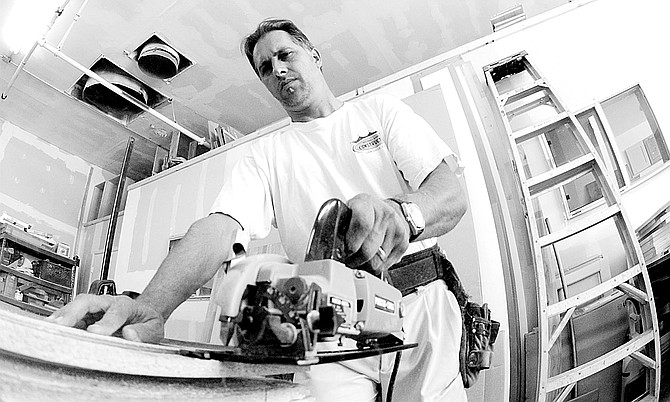
Have your friends and neighbors looked weighed down, put upon, or bent low to the ground lately? Perhaps they are! After all, many of the people we see around us tote a good deal of gear around with them: Chainsaws and helmets, toolbelts and chests, clown shoes and rubber noses. These are just some of the implements people use to earn their daily bread.
To find out more about the tools people use, and the ways they use them, I tracked down seven men and women working in seven different professions and asked them to describe their jobs, the tools it took to do them, and any rituals and superstitions that might have built up around those tools. Then, in order to see just how burdensome those jobs could be, I calculated the precise weight of those tools -- down to the nearest ounce. Below, my results:
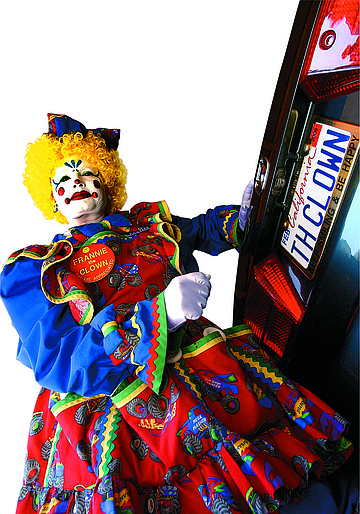
When I get started doing my makeup, I give myself an hour and a half just to put on my face. I need another 15 to 20 minutes to put on my costume. Then I gather my things and pack up my car. I allow myself at least an hour to get to a program. I'm always fashionably early.
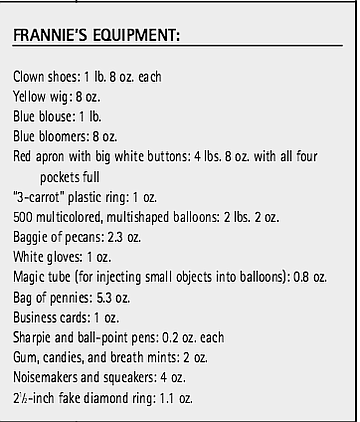
I put my makeup on more or less the same way every time. After you "cut out" the white design you use for your base, you put the colors on, and after the colors, you have to set it, because it's all greasepaint. You set it with baby powder, then you brush that off and start applying sparkles. A clown is supposed to be completely covered when he or she goes out to be a clown. No skin showing through; it's all makeup and costume. Once in a while I'll take off my gloves to do some face painting, or something like it.
My costume goes: blouse, bloomers, apron, socks, shoes, collar, and wig, in that order. Then I fill my pockets. Balloons and squeakers, little noisemakers, different types of clown rings, business cards, stickers. That sort of thing. Then I have to load my car up. I put in table and chair, my bubbles and balloons, my electric pump, and the cart I use to push this stuff around in.
Of course, what I take to a hospital is different from what I'd take to a birthday party. I do lots of room visits in the hospitals, so I don't need my table and my chair. A lot of times, I'll prepare 200 balloons before I leave in the morning. I get them ready beforehand because I sometimes do three or four hospitals back to back, and I'll do dozens of balloon animals in each one.
When you're a clown, you stay in makeup until you get home. So driving home from work, you're still a clown. And, trying to drive in clown shoes, let me tell you.... When I do get home, I take the wig off first, then the costume. The makeup is greasepaint, so getting it off involves baby oil and baby wipes. And the older and more wrinkled I get, the longer it takes. These days, it takes me anywhere from 20 minutes to a half an hour.
My character, Frannie the Clown, is the child I never had. So trust me, if there's something out there Frannie wants, then Frannie gets it. I have pretty much all of the state-of-the-art equipment. When I have old things I don't want or need anymore, I'll give them to new clowns. Frannie the Clown gets a new wig every month or two months, and I give my old wigs to churches, children, other clowns. I used to wear red hair all the time. These days, I have bright yellow hair. I used to say, "Blondes have more fun, but redheads get the job done." And now that Frannie's a blonde, I say, "Blondes have more fun and they get the job done!"
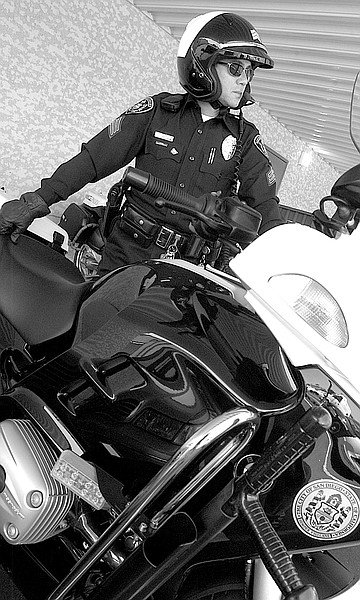
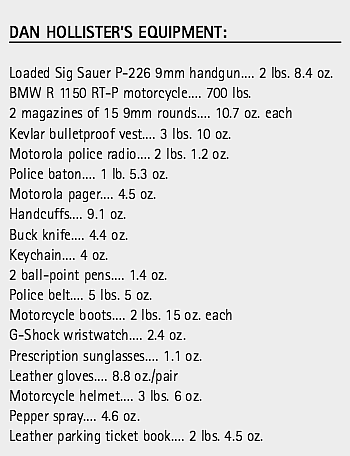
I've been on the San Diego police force for over 20 years. Thirteen on a SWAT team, and the last 7 on a motorcycle squad. I follow a definite routine when I get ready for work; everything goes on in a specific order, especially during the winter months when you're putting on additional layers of clothing. The motorpants go on first. If it's cold enough, I'll put long underpants on before the motorbritches. Then comes a T-shirt and bulletproof vest. Cold mornings I might put on a turtleneck on top of that. Then comes the uniform shirt, then the leather jacket and the police belt.
I don't have any superstitions when it comes to getting ready. As long as everything goes on, fits correctly, and feels good, then it's good to go. I mean, you double check everything; you don't want to walk out of your house without your gun, but if everything is where it's supposed to be, then that's enough for me.
Motorcycle officers don't forget things as often as patrol officers, because motorcycle officers get ready at home and then ride into work. Patrol officers come to work in their civilian vehicles and then get ready in the locker room. Me, I have a walk-in closet in the master bedroom where I store everything so that it's out of reach of my kids.
Everything I carry to work with me is special; it all has a purpose. But if I had to pick a favorite tool, it would have to be my firearm. That's the bread and butter. The motorcycle isn't a luxury; it's something I need to do my job. But I think if you ask any law-enforcement officer to pick one tool, then the firearm is the one that makes all the difference in the world.
I've used my gun, but I've never had to fire it. I'm lucky. I've used the gun to gain compliance in various situations. Knock on wood, the bulletproof vest is the one thing that I've never had to use. Yet.
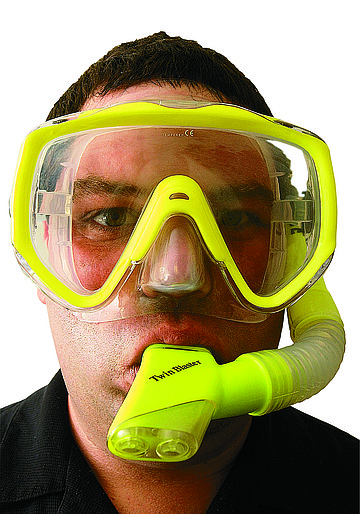

The first thing you want to do when you're getting ready to dive is hook up your dive gear. You don't want to do it after your wetsuit's on or you're roasting. So you put your dive gear together first and you make sure that it's working. After your dive gear's hooked up, you put your wetsuit on, you put your dive gear on, and then you head into the water.
You want to spend as little time as possible on land with your wetsuit on and your dive gear on your back. Once you're in the water, it gets a lot lighter, so you want to get ready as close to the water's edge as possible. Getting ready for diving only takes about six or seven minutes, and after you get done diving, you can take off your dive gear at the water's edge, then walk back to the car and take the wetsuit off.
It's important to rinse all your gear after you're done diving, get the salt off of it. All the stuff gets rinsed off and dried and then you spread it out and hang it up and pack it away for the next time. You also have to spray the metal stuff — the regulators and computers and lights — with silicon spray so it won't rust.
I really like my drysuit, which is exactly what it sounds like. It's a dry suit. It keeps all the water off you so you stay totally dry. It means you can get dressed up in nice, warm, fuzzy underwear at home, go down to the dive site, leave your clothes on, and just put your suit over them. That's a lot more comfortable.
There isn't any equipment that I wish I had. I own a dive store. I've got all the toys I want! But the things I have that I never use are my knife and my emergency backup tank. I always carry an extra tank with an extra regulator, just in case mine goes bad. But so far, in 18 years of diving, I've never had to use it. The knife I have just in case. You wouldn't fight a shark or anything with it, but maybe I'll have to cut myself out of fishing line someday — you never know!
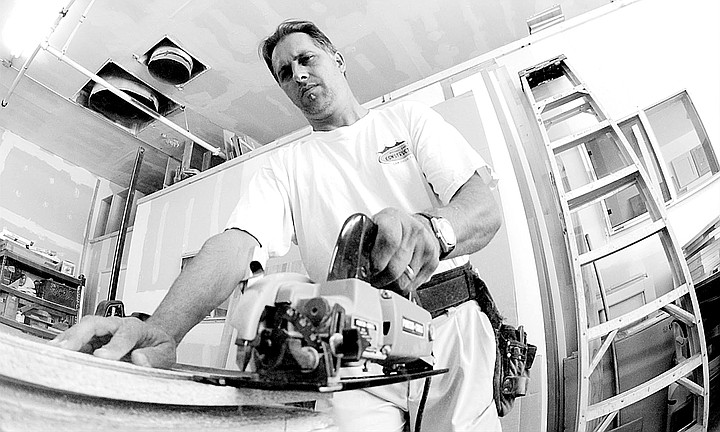
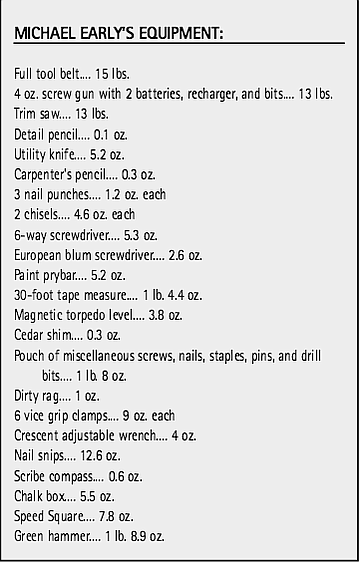
I've worked in construction for almost 30 years, starting with geodesic domes I built in Michigan at the age of 15. My tool belt — construction workers call them "bags" — are usually set up beforehand. I know where all my parts are, I don't even have to look. I can just grab anywhere and I know what I'm going to find.
So you put your bags on first, because you're going to need all those hand tools. Beyond that, you have to decide what tools are going to be necessary for the job. Certain tools you'll need to have with you, and everything else you can just leave in the truck.
I'll walk under ladders; I don't have any of those issues. But my green hammer has to be with me at all times. Everybody laughs about it, but it's been with me for 20 years. I do everything with it, and I can't lose it, or I actually freak out.
I only leave my tools lying around after work if the job site's really secure. Otherwise, you'll get ripped off. I've had stuff stolen on jobs in this town. For instance, we're in another room, in a big house in Hillcrest, and we come back, and a chop saw's stolen. So I advise all my employees, every day, to spend the extra 15 minutes, roll their tools up. Otherwise, sure enough, another tradesman will steal them. And in this business, that's your life, you know? You make your earnings based on what tools you own.
My green hammer is one of my favorite tools, of course, but another one of my favorites is my Porter-Cable four-and-a-half-inch trim saw. That's a tool. I do everything with it. I can do it all with this little thing, like cut finished panels with it. But I own a lot of tools; I have thousands of dollars in tools. I used to like to get tools for the fun of it. But now that I'm managing a construction company, I want to see how much I can do with the least amount of tools. So I'm kind of working it backwards and trying to be more efficient. If your team's portable, you can grab a couple of things and do more with less.
I have one tool I never use -- a $300 electric pocket cutter, a special tool for making frames of cabinets. I use one that was $10, one you clamp and use with a screw gun. So that's a good example of a tool that I wanted and got but didn't really need, and now that I have it, I don't like it.
You never sell your old tools. I've done it before, but when you sell them, you go, "Gosh, I wish I had that staple gun back." On the other hand, when you acquire a new tool, you can't really get the money back for it. I have this thing called an electric shear, which you use for cutting metal. I haven't used it for three years. I'm going to use it again in the next couple of days, and then I probably won't use it again for another five years. But it's a $200 tool, and I'm glad I have it.
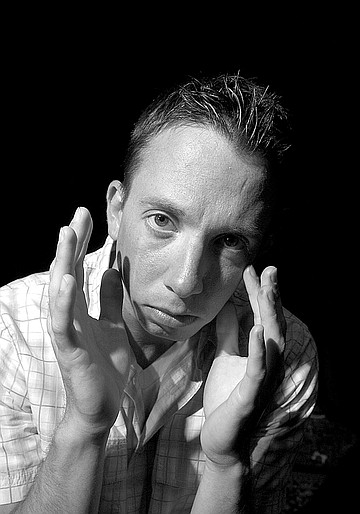
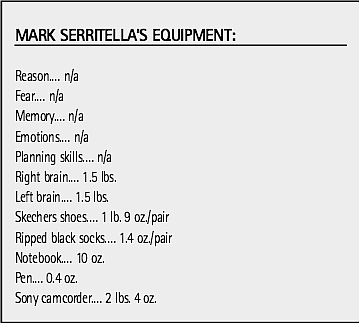
I've been doing comedy for six years, and my comedy show runs every Tuesday at Lestat's Coffeehouse in Normal Heights. So I write all week long and go through my jokes, list them, and I categorize them by women, politics, inventions, animals -- you know, whatever themes seem to be emerging in the jokes that I'm doing. Before each show, I rehearse them once or twice. I used to rehearse all week long, probably 50 times. But lately, I've been doing my rehearsing about 20 minutes before each show, running through it twice, just before I go onstage. Even the new material. I write new stuff all the time, and your brain just becomes more attuned to memorizing stuff.
I don't have any superstitions about my preparation, but I do like to wear the same shoes and socks. You can't do comedy in uncomfortable shoes! If your shoes are really heavy, your mind focuses on that -- you can get bogged down by the weight of your own feet.
I just bought a new pair of performing shoes. I was at the mall in these dress shoes. Doing jumping jacks in them. You know, they almost have to feel like sneakers. And I wear these black dress socks. They're not long, so they're not hot, and I wear the same pair every time I do an important show. Actually, they just ripped, which kind of sucks, because now I'll have to quit comedy.
At the end of each set, I take a notebook of the jokes I just did and put a star next to the ones that worked. I write a new ten-minute set every single week, so I have to keep track. By putting a star next to the jokes that work, I remember them, so that the next time I'm going to do a 40-minute set, I can take all my best stuff from the last three or four months and put it all together to make a headline set.
My favorite piece of specialized equipment is definitely my brain. You know, the left side of the brain is for planning and goal-setting. I plan out my entire career with the left side of my brain: What managers I would like to manage me. How I can go about getting them. If I want a new CD to come out. Where I'm going to work. Which clubs I like. Who I need to talk to. Whether I need to mail out a demo. And so on.
The right side of my brain is for emotion and creativity. When you're onstage, those are the things you use. The right side is probably my favorite part because it's for performance. The right side is also for consciousness -- when you're onstage, you have to be really focused on the room. You have to be in the room. You have to be totally present. There's a part of the brain that controls reason, but when you're onstage, you can get unreasonable, so I think that reason's a tool I could learn to use better.
Fear and memory are also important tools that you have to know how to use to do comedy. There's a lot of fear onstage, especially when you first start, and one of the first things that you lose when you're afraid is your memory. Early on, I'd have to memorize three minutes' worth of jokes, but when I'd get up there, completely untrained and completely afraid, I'd forget two of the three minutes, and I'd have to just walk off the stage. I think that, as you get less fearful, your memory becomes much better.
I also bring a camcorder to every set. You get better by watching yourself, seeing all the little things you do with your body. Like, I did all this voice and speech work last year -- I was losing my voice -- and I noticed I was doing this puffy chest-thing, trying to keep my diaphragm out. It was like I was trying to look bigger than I am. When I saw it on tape, I thought, "I've got to stop doing that!"
I go through all the emotions onstage, so I use my right brain all the time. If there's a tool I don't use much, it must be a left-brain issue. Although, in comedy, I think you do use all of your brain all the time. If you're any good, I mean. A lot of comedians don't do a lot of planning. If you ask me, that's not a really good idea.
I've been a team member of San Diego Mountain Rescue for 13 years. I'm a systems analyst for Xerox by day, but I'm always on call, and I participate in roughly 30 rescue operations a year.
A mountain rescue team is composed of the leader, a gofer, a litter attendant, a hauler, a rigger, and a safety man. Aside from the team leader, everyone can do everyone else's job. There are no specialists. When I'm called for a job, I first have to come home and put my pack together. And what I pack depends on the nature of the operation. If I know that it's going to be a technical call, I'll pack the majority of my rock gear. Sometimes we do urban searches, where we just walk down streets and alleys. In that case, I'll bring a much lighter pack. But we do have what we call a standard field pack, which includes things like a first-aid kit, a compass, map, GPS, a Swiss Army knife. It's a basic, self-sufficient kind of pack.
When I assemble my pack, I organize it a specific way. That way, when I'm in the field, if I need my first-aid kit, then I know right where it's at, or if I need my technical gear, it's always there for me to find it right away. When you're packing, you want to think about evening out the weight distribution and about getting the weight-center of the pack to be lower and closer to your back. My heavy, technical gear will typically go in first. And you always want the stuff that you're going to need quickly on the top. The first-aid kit is always on the top and ready to grab. Also my food, because we rarely stop and have lunch; it's we more like graze on power bars and trail mix, stuff like that. Water should always be handy. Sometimes I use water bottles, and sometimes I use a device that has the hose connected to it.
The pack itself is just a typical internal frame backpack. When we go out in the field, we wear blue pants, a warm shirt, and boots, plus the backpack. That's about it. It doesn't take me long to get ready, because the stuff in my garage is pretty well organized. Usually, from the time I get home to when I'm packed, changed, and ready to go, about half an hour goes by. Most times, it has to be quick. I don't unpack after a job, because usually when I come home from a search I'm pretty beat. It's not uncommon to get a call at 10 o'clock at night. Then we'll go out, search all night, and get home first thing in the morning. You just crash out.
My favorite piece of gear, I think, is my ice axe. We were on quite a few rescues in the San Bernardinos this year; it came in handy. But all of my equipment is easy to use and lightweight. Because when you're on an operation, you're always concerned with volume and weight. Whether you're on a technical rescue or you're out in the field, you always want the smallest and lightest. And San Diego has a lot of brush, so we often find ourselves brush-crawling. We call it "manzanita stomping." So if you have a big old pack that weighs a lot, you'll feel like you're dying. I'd say my average pack weight is 30 to 35 pounds, depending on the rescue. (Unless you're doing winter rescue, in which case the pack weighs quite a bit more, because you have to have a stove, a shelter, and warmer clothes on top of all the other stuff. The winter pack is closer to 50 or 60 pounds.)
I've had a lot of my equipment for a while, so it's kind of older and heavier, but it's still in pretty good shape. There's always something lighter and smaller. Some new titanium gadget, something ultralight that's just been invented. But I have to wait until something breaks before I buy the nifty new version. One of the things that you specifically think about when you pack your pack is that you don't want anything that you're not going to use. Typically if I have something that I haven't used in a couple of years, then I'll either sell it or give it away.
It's about efficiency. Having what you need but not having too much.
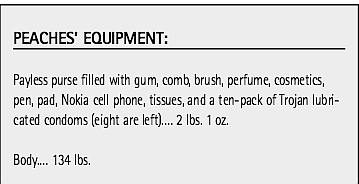
I've been hooking on and off since 1989, and every night when I go to work, I make sure I have protection: I carry a pair of scissors, a screwdriver, and a water gun filled with bleach and rubbing alcohol.
I used the water gun once; squirted a guy in the eyes. That's the only protection I carry. But in my purse I have cosmetics, a pen and paper to write with, condoms, my cell phone... That there's my wine. Gets me in the mood, sometimes. It's Cisco!
I wear different outfits depending on the weather, but I don't dress too obvious. I want to draw some attention to myself, but not too much, so I dress conservative. I'll be walking and I'll get that eye contact with that person, you know, it's something. We'll have a kind of way of knowing what's going on. Sometimes it takes me a while to get out of the house when I go to work at night, and sometimes I can get ready real quick. Like 15 minutes. It depends on my mood.
On the weekends, or when it's paydays for people, I'll start work at, like, 10 at night, and it'll be daylight when I finish. I usually stay in a hotel, but the last few days I've been living with someone in an apartment. And when I get home from working, I just throw my stuff down next to the bed. Or wherever. It don't matter.
I can't carry too much on me, just my purse, but I do love my cell phone. I got a Nokia phone, and my service is with Cingular. I got unlimited minutes after 7. And, I got gum. Today it's extra spearmint, but my favorite is Dentyne Ice, the Arctic Chill gum. So I also carry gum, a comb, a brush, my shades, cosmetics, and my perfume. I wear Sparkling White Diamonds by Elizabeth Taylor. I used to carry a vibrator, you know, for me. Some guys did like it, though. But I don't carry that no more; it got stolen. I done lost so many purses out here, I can't even tell you.
And, you know, I guess my body is one of my tools. My body is my best tool. Guys really like that tool the best.
I work for myself. I never had a pimp. I been told that I'm disrespecting the game by not having a pimp, but nobody's ever hurt me, not really. Like I said, I did have to use my water gun once, because this guy had, like, a screwdriver or a stick or something up to my neck. Actually, he was, like, raping me. He didn't want to pay for the services. He just wanted me to give it to him. So I got him in the eyes. Anyway, everything in my purse, I use. I just bought this purse at Payless. It's a Payless purse!


Have your friends and neighbors looked weighed down, put upon, or bent low to the ground lately? Perhaps they are! After all, many of the people we see around us tote a good deal of gear around with them: Chainsaws and helmets, toolbelts and chests, clown shoes and rubber noses. These are just some of the implements people use to earn their daily bread.
To find out more about the tools people use, and the ways they use them, I tracked down seven men and women working in seven different professions and asked them to describe their jobs, the tools it took to do them, and any rituals and superstitions that might have built up around those tools. Then, in order to see just how burdensome those jobs could be, I calculated the precise weight of those tools -- down to the nearest ounce. Below, my results:

When I get started doing my makeup, I give myself an hour and a half just to put on my face. I need another 15 to 20 minutes to put on my costume. Then I gather my things and pack up my car. I allow myself at least an hour to get to a program. I'm always fashionably early.

I put my makeup on more or less the same way every time. After you "cut out" the white design you use for your base, you put the colors on, and after the colors, you have to set it, because it's all greasepaint. You set it with baby powder, then you brush that off and start applying sparkles. A clown is supposed to be completely covered when he or she goes out to be a clown. No skin showing through; it's all makeup and costume. Once in a while I'll take off my gloves to do some face painting, or something like it.
My costume goes: blouse, bloomers, apron, socks, shoes, collar, and wig, in that order. Then I fill my pockets. Balloons and squeakers, little noisemakers, different types of clown rings, business cards, stickers. That sort of thing. Then I have to load my car up. I put in table and chair, my bubbles and balloons, my electric pump, and the cart I use to push this stuff around in.
Of course, what I take to a hospital is different from what I'd take to a birthday party. I do lots of room visits in the hospitals, so I don't need my table and my chair. A lot of times, I'll prepare 200 balloons before I leave in the morning. I get them ready beforehand because I sometimes do three or four hospitals back to back, and I'll do dozens of balloon animals in each one.
When you're a clown, you stay in makeup until you get home. So driving home from work, you're still a clown. And, trying to drive in clown shoes, let me tell you.... When I do get home, I take the wig off first, then the costume. The makeup is greasepaint, so getting it off involves baby oil and baby wipes. And the older and more wrinkled I get, the longer it takes. These days, it takes me anywhere from 20 minutes to a half an hour.
My character, Frannie the Clown, is the child I never had. So trust me, if there's something out there Frannie wants, then Frannie gets it. I have pretty much all of the state-of-the-art equipment. When I have old things I don't want or need anymore, I'll give them to new clowns. Frannie the Clown gets a new wig every month or two months, and I give my old wigs to churches, children, other clowns. I used to wear red hair all the time. These days, I have bright yellow hair. I used to say, "Blondes have more fun, but redheads get the job done." And now that Frannie's a blonde, I say, "Blondes have more fun and they get the job done!"


I've been on the San Diego police force for over 20 years. Thirteen on a SWAT team, and the last 7 on a motorcycle squad. I follow a definite routine when I get ready for work; everything goes on in a specific order, especially during the winter months when you're putting on additional layers of clothing. The motorpants go on first. If it's cold enough, I'll put long underpants on before the motorbritches. Then comes a T-shirt and bulletproof vest. Cold mornings I might put on a turtleneck on top of that. Then comes the uniform shirt, then the leather jacket and the police belt.
I don't have any superstitions when it comes to getting ready. As long as everything goes on, fits correctly, and feels good, then it's good to go. I mean, you double check everything; you don't want to walk out of your house without your gun, but if everything is where it's supposed to be, then that's enough for me.
Motorcycle officers don't forget things as often as patrol officers, because motorcycle officers get ready at home and then ride into work. Patrol officers come to work in their civilian vehicles and then get ready in the locker room. Me, I have a walk-in closet in the master bedroom where I store everything so that it's out of reach of my kids.
Everything I carry to work with me is special; it all has a purpose. But if I had to pick a favorite tool, it would have to be my firearm. That's the bread and butter. The motorcycle isn't a luxury; it's something I need to do my job. But I think if you ask any law-enforcement officer to pick one tool, then the firearm is the one that makes all the difference in the world.
I've used my gun, but I've never had to fire it. I'm lucky. I've used the gun to gain compliance in various situations. Knock on wood, the bulletproof vest is the one thing that I've never had to use. Yet.


The first thing you want to do when you're getting ready to dive is hook up your dive gear. You don't want to do it after your wetsuit's on or you're roasting. So you put your dive gear together first and you make sure that it's working. After your dive gear's hooked up, you put your wetsuit on, you put your dive gear on, and then you head into the water.
You want to spend as little time as possible on land with your wetsuit on and your dive gear on your back. Once you're in the water, it gets a lot lighter, so you want to get ready as close to the water's edge as possible. Getting ready for diving only takes about six or seven minutes, and after you get done diving, you can take off your dive gear at the water's edge, then walk back to the car and take the wetsuit off.
It's important to rinse all your gear after you're done diving, get the salt off of it. All the stuff gets rinsed off and dried and then you spread it out and hang it up and pack it away for the next time. You also have to spray the metal stuff — the regulators and computers and lights — with silicon spray so it won't rust.
I really like my drysuit, which is exactly what it sounds like. It's a dry suit. It keeps all the water off you so you stay totally dry. It means you can get dressed up in nice, warm, fuzzy underwear at home, go down to the dive site, leave your clothes on, and just put your suit over them. That's a lot more comfortable.
There isn't any equipment that I wish I had. I own a dive store. I've got all the toys I want! But the things I have that I never use are my knife and my emergency backup tank. I always carry an extra tank with an extra regulator, just in case mine goes bad. But so far, in 18 years of diving, I've never had to use it. The knife I have just in case. You wouldn't fight a shark or anything with it, but maybe I'll have to cut myself out of fishing line someday — you never know!


I've worked in construction for almost 30 years, starting with geodesic domes I built in Michigan at the age of 15. My tool belt — construction workers call them "bags" — are usually set up beforehand. I know where all my parts are, I don't even have to look. I can just grab anywhere and I know what I'm going to find.
So you put your bags on first, because you're going to need all those hand tools. Beyond that, you have to decide what tools are going to be necessary for the job. Certain tools you'll need to have with you, and everything else you can just leave in the truck.
I'll walk under ladders; I don't have any of those issues. But my green hammer has to be with me at all times. Everybody laughs about it, but it's been with me for 20 years. I do everything with it, and I can't lose it, or I actually freak out.
I only leave my tools lying around after work if the job site's really secure. Otherwise, you'll get ripped off. I've had stuff stolen on jobs in this town. For instance, we're in another room, in a big house in Hillcrest, and we come back, and a chop saw's stolen. So I advise all my employees, every day, to spend the extra 15 minutes, roll their tools up. Otherwise, sure enough, another tradesman will steal them. And in this business, that's your life, you know? You make your earnings based on what tools you own.
My green hammer is one of my favorite tools, of course, but another one of my favorites is my Porter-Cable four-and-a-half-inch trim saw. That's a tool. I do everything with it. I can do it all with this little thing, like cut finished panels with it. But I own a lot of tools; I have thousands of dollars in tools. I used to like to get tools for the fun of it. But now that I'm managing a construction company, I want to see how much I can do with the least amount of tools. So I'm kind of working it backwards and trying to be more efficient. If your team's portable, you can grab a couple of things and do more with less.
I have one tool I never use -- a $300 electric pocket cutter, a special tool for making frames of cabinets. I use one that was $10, one you clamp and use with a screw gun. So that's a good example of a tool that I wanted and got but didn't really need, and now that I have it, I don't like it.
You never sell your old tools. I've done it before, but when you sell them, you go, "Gosh, I wish I had that staple gun back." On the other hand, when you acquire a new tool, you can't really get the money back for it. I have this thing called an electric shear, which you use for cutting metal. I haven't used it for three years. I'm going to use it again in the next couple of days, and then I probably won't use it again for another five years. But it's a $200 tool, and I'm glad I have it.


I've been doing comedy for six years, and my comedy show runs every Tuesday at Lestat's Coffeehouse in Normal Heights. So I write all week long and go through my jokes, list them, and I categorize them by women, politics, inventions, animals -- you know, whatever themes seem to be emerging in the jokes that I'm doing. Before each show, I rehearse them once or twice. I used to rehearse all week long, probably 50 times. But lately, I've been doing my rehearsing about 20 minutes before each show, running through it twice, just before I go onstage. Even the new material. I write new stuff all the time, and your brain just becomes more attuned to memorizing stuff.
I don't have any superstitions about my preparation, but I do like to wear the same shoes and socks. You can't do comedy in uncomfortable shoes! If your shoes are really heavy, your mind focuses on that -- you can get bogged down by the weight of your own feet.
I just bought a new pair of performing shoes. I was at the mall in these dress shoes. Doing jumping jacks in them. You know, they almost have to feel like sneakers. And I wear these black dress socks. They're not long, so they're not hot, and I wear the same pair every time I do an important show. Actually, they just ripped, which kind of sucks, because now I'll have to quit comedy.
At the end of each set, I take a notebook of the jokes I just did and put a star next to the ones that worked. I write a new ten-minute set every single week, so I have to keep track. By putting a star next to the jokes that work, I remember them, so that the next time I'm going to do a 40-minute set, I can take all my best stuff from the last three or four months and put it all together to make a headline set.
My favorite piece of specialized equipment is definitely my brain. You know, the left side of the brain is for planning and goal-setting. I plan out my entire career with the left side of my brain: What managers I would like to manage me. How I can go about getting them. If I want a new CD to come out. Where I'm going to work. Which clubs I like. Who I need to talk to. Whether I need to mail out a demo. And so on.
The right side of my brain is for emotion and creativity. When you're onstage, those are the things you use. The right side is probably my favorite part because it's for performance. The right side is also for consciousness -- when you're onstage, you have to be really focused on the room. You have to be in the room. You have to be totally present. There's a part of the brain that controls reason, but when you're onstage, you can get unreasonable, so I think that reason's a tool I could learn to use better.
Fear and memory are also important tools that you have to know how to use to do comedy. There's a lot of fear onstage, especially when you first start, and one of the first things that you lose when you're afraid is your memory. Early on, I'd have to memorize three minutes' worth of jokes, but when I'd get up there, completely untrained and completely afraid, I'd forget two of the three minutes, and I'd have to just walk off the stage. I think that, as you get less fearful, your memory becomes much better.
I also bring a camcorder to every set. You get better by watching yourself, seeing all the little things you do with your body. Like, I did all this voice and speech work last year -- I was losing my voice -- and I noticed I was doing this puffy chest-thing, trying to keep my diaphragm out. It was like I was trying to look bigger than I am. When I saw it on tape, I thought, "I've got to stop doing that!"
I go through all the emotions onstage, so I use my right brain all the time. If there's a tool I don't use much, it must be a left-brain issue. Although, in comedy, I think you do use all of your brain all the time. If you're any good, I mean. A lot of comedians don't do a lot of planning. If you ask me, that's not a really good idea.
I've been a team member of San Diego Mountain Rescue for 13 years. I'm a systems analyst for Xerox by day, but I'm always on call, and I participate in roughly 30 rescue operations a year.
A mountain rescue team is composed of the leader, a gofer, a litter attendant, a hauler, a rigger, and a safety man. Aside from the team leader, everyone can do everyone else's job. There are no specialists. When I'm called for a job, I first have to come home and put my pack together. And what I pack depends on the nature of the operation. If I know that it's going to be a technical call, I'll pack the majority of my rock gear. Sometimes we do urban searches, where we just walk down streets and alleys. In that case, I'll bring a much lighter pack. But we do have what we call a standard field pack, which includes things like a first-aid kit, a compass, map, GPS, a Swiss Army knife. It's a basic, self-sufficient kind of pack.
When I assemble my pack, I organize it a specific way. That way, when I'm in the field, if I need my first-aid kit, then I know right where it's at, or if I need my technical gear, it's always there for me to find it right away. When you're packing, you want to think about evening out the weight distribution and about getting the weight-center of the pack to be lower and closer to your back. My heavy, technical gear will typically go in first. And you always want the stuff that you're going to need quickly on the top. The first-aid kit is always on the top and ready to grab. Also my food, because we rarely stop and have lunch; it's we more like graze on power bars and trail mix, stuff like that. Water should always be handy. Sometimes I use water bottles, and sometimes I use a device that has the hose connected to it.
The pack itself is just a typical internal frame backpack. When we go out in the field, we wear blue pants, a warm shirt, and boots, plus the backpack. That's about it. It doesn't take me long to get ready, because the stuff in my garage is pretty well organized. Usually, from the time I get home to when I'm packed, changed, and ready to go, about half an hour goes by. Most times, it has to be quick. I don't unpack after a job, because usually when I come home from a search I'm pretty beat. It's not uncommon to get a call at 10 o'clock at night. Then we'll go out, search all night, and get home first thing in the morning. You just crash out.
My favorite piece of gear, I think, is my ice axe. We were on quite a few rescues in the San Bernardinos this year; it came in handy. But all of my equipment is easy to use and lightweight. Because when you're on an operation, you're always concerned with volume and weight. Whether you're on a technical rescue or you're out in the field, you always want the smallest and lightest. And San Diego has a lot of brush, so we often find ourselves brush-crawling. We call it "manzanita stomping." So if you have a big old pack that weighs a lot, you'll feel like you're dying. I'd say my average pack weight is 30 to 35 pounds, depending on the rescue. (Unless you're doing winter rescue, in which case the pack weighs quite a bit more, because you have to have a stove, a shelter, and warmer clothes on top of all the other stuff. The winter pack is closer to 50 or 60 pounds.)
I've had a lot of my equipment for a while, so it's kind of older and heavier, but it's still in pretty good shape. There's always something lighter and smaller. Some new titanium gadget, something ultralight that's just been invented. But I have to wait until something breaks before I buy the nifty new version. One of the things that you specifically think about when you pack your pack is that you don't want anything that you're not going to use. Typically if I have something that I haven't used in a couple of years, then I'll either sell it or give it away.
It's about efficiency. Having what you need but not having too much.

I've been hooking on and off since 1989, and every night when I go to work, I make sure I have protection: I carry a pair of scissors, a screwdriver, and a water gun filled with bleach and rubbing alcohol.
I used the water gun once; squirted a guy in the eyes. That's the only protection I carry. But in my purse I have cosmetics, a pen and paper to write with, condoms, my cell phone... That there's my wine. Gets me in the mood, sometimes. It's Cisco!
I wear different outfits depending on the weather, but I don't dress too obvious. I want to draw some attention to myself, but not too much, so I dress conservative. I'll be walking and I'll get that eye contact with that person, you know, it's something. We'll have a kind of way of knowing what's going on. Sometimes it takes me a while to get out of the house when I go to work at night, and sometimes I can get ready real quick. Like 15 minutes. It depends on my mood.
On the weekends, or when it's paydays for people, I'll start work at, like, 10 at night, and it'll be daylight when I finish. I usually stay in a hotel, but the last few days I've been living with someone in an apartment. And when I get home from working, I just throw my stuff down next to the bed. Or wherever. It don't matter.
I can't carry too much on me, just my purse, but I do love my cell phone. I got a Nokia phone, and my service is with Cingular. I got unlimited minutes after 7. And, I got gum. Today it's extra spearmint, but my favorite is Dentyne Ice, the Arctic Chill gum. So I also carry gum, a comb, a brush, my shades, cosmetics, and my perfume. I wear Sparkling White Diamonds by Elizabeth Taylor. I used to carry a vibrator, you know, for me. Some guys did like it, though. But I don't carry that no more; it got stolen. I done lost so many purses out here, I can't even tell you.
And, you know, I guess my body is one of my tools. My body is my best tool. Guys really like that tool the best.
I work for myself. I never had a pimp. I been told that I'm disrespecting the game by not having a pimp, but nobody's ever hurt me, not really. Like I said, I did have to use my water gun once, because this guy had, like, a screwdriver or a stick or something up to my neck. Actually, he was, like, raping me. He didn't want to pay for the services. He just wanted me to give it to him. So I got him in the eyes. Anyway, everything in my purse, I use. I just bought this purse at Payless. It's a Payless purse!
Comments